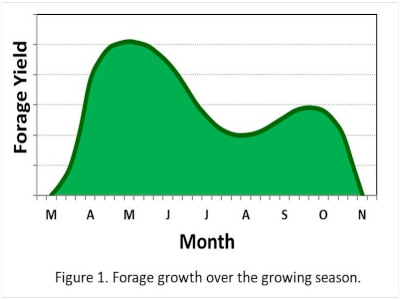By Kim Cassida and Kable Thurlow
When the grass starts greening, the urge to get livestock on pasture is strong. However, patience and a little planning will pay off because management of the spring flush of forage availability is key to setting the tone for the entire grazing season.

When the grass starts greening, the urge to get cattle on pasture is strong. However, patience and a little planning will pay off because management of the spring flush of forage availability is key to setting the tone for the entire grazing season. Rotational stocking systems are the most important tool producers have to manage forage growth and supply throughout the season, but these require some forethought for effective use.
First, a little plant physiology is in order. Most perennial pasture species in Michigan are in the cool-season functional group which typically breaks dormancy in late March through April, depending on location in Michigan. In most species, the first growth comes from reproductive buds that were formed the previous fall and is fueled by sugars, nitrogen, and minerals stored from the previous growing season. Legumes mostly store their reserves in below ground structures like crowns or rhizomes, while grasses store reserves in the lower part of stems. Grasses only store reserves below ground if rhizomes are present in species such as smooth bromegrass, tall fescue, reed canarygrass, and Kentucky bluegrass. Consequently, grazing grasses too early can reduce productivity because cattle will tend to graze the lower stem when nothing else is available.
Grasses exhibit explosive growth in spring due to the dominance of reproductive tillers. This is what causes the “spring flush” of growth (Figure 1). This uneven growth over the season can have several negative consequences. Spring forage production often exceeds the ability of available cattle to consume it. As seed heads develop, forage availability per acre increases but nutritional value decreases because of the high proportion of less digestible stem tissue relative to highly digestible leaves. Shading from heavy spring growth can reduce establishment of frost-seeded legumes. Lastly, shading and the presence of reproductive tillers in many grasses also suppresses development of new buds and reduces the ability of the paddock to recover quickly after grazing.
It is easy to find recommendations to delay grazing spring pastures until grass is 8 to 10 inches tall. Under continuous stocking systems this may help protect grass from overgrazing. In rotational stocking systems, waiting this long will almost certainly guarantee that grasses are in the exponential growth phase and most paddocks will be too mature by the time cattle get to them. A better strategy is to begin grazing before you think the paddocks are ready, perhaps when grass averages only 4 to 6 inches tall. At this stage of growth, cattle should be rotated rapidly through the paddocks (no longer than 24 hours per paddock, perhaps as short as 8 to 12 hours), taking only the tops. As grass growth accelerates, this will help keep grass vegetative and stage regrowth over time for subsequent grazing cycles. Rapid rotation also helps reduce pugging damage in the event of the wet spring soils that are so common in Michigan.
Paddock grazing sequence should be planned so that paddocks that were grazed last in the fall are given extra spring rest, and not grazed early in spring. A different paddock should be grazed first each year.
Temporarily increasing stocking rate by adding extra cattle, such as stockers, to pastures can help utilize the extra growth expected in spring. If this is not practical for the operation, then plan to set aside some paddocks to accumulate forage once the cattle can no longer keep up. It is better to allow a few paddocks to get over -mature than to fall behind on all of them. The set-aside paddocks can be harvested as hay or baleage or used as a standing forage stockpile for summer grazing by animals with low nutritional needs. Over-mature paddocks can also be machine-clipped to induce regrowth and improve forage quality if the extra cost is justified by the animals being grazed.
Ideally, all soil testing with subsequent recommended lime, P, or K applications was done last fall. If not, this can be also done in the spring as early as you can drive on the pasture or after any grazing cycle if spring soil is too wet. Nitrogen, however, should not be applied to pastures before the first grazing in spring. Applying spring nitrogen is a strong driver of plant growth and simply pours gas on the problem of more forage than cattle can eat during the spring flush. Instead, apply split rates of 25 to 50 pounds per acre N after the first, second, and third grazing cycles to help drive forage growth through the summer and even out the forage supply. Applying nitrogen to pastures with more than 30% legume content (clovers, alfalfa, and birdsfoot trefoil) is often not cost effective because the legumes provide enough nitrogen for the grass.
Spring pasture turn-out is something to look forward to and does not have to be overcomplicated. The hardest part of any job is getting started. Get the fences in good repair, the watering system in tip top shape and the livestock’s belly full of feed before you open the gate for the first time, and you will be off to a good start.
Source : msu.edu